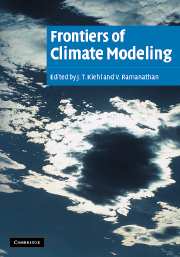Book contents
- Frontmatter
- Contents
- Preface
- List of Contributors
- Acknowledgments
- 1 Overview of climate modeling
- 2 Climate-change modeling: a brief history of the theory and recent twenty-first-century ensemble simulations
- 3 Energy-balance climate models
- 4 Intrinsic climatic variability: an essay on modes and mechanisms of oceanic and atmospheric fluid dynamics
- 5 The radiative forcing due to clouds and water vapor
- 6 A model study of the effect of Pinatubo volcanic aerosols on stratospheric temperatures
- 7 Unresolved issues in atmospheric solar absorption
- 8 Cloud feedbacks
- 9 Water-vapor feedback
- 10 Water-vapor observations
- 11 New frontiers in remote sensing of aerosols and their radiative forcing of climate
- 12 Cloud–climate feedback: lessons learned from two El Niño events
- 13 Runaway greenhouses and runaway glaciations: how stable is Earth's climate?
- Glossary
- Plate section
2 - Climate-change modeling: a brief history of the theory and recent twenty-first-century ensemble simulations
Published online by Cambridge University Press: 12 August 2009
- Frontmatter
- Contents
- Preface
- List of Contributors
- Acknowledgments
- 1 Overview of climate modeling
- 2 Climate-change modeling: a brief history of the theory and recent twenty-first-century ensemble simulations
- 3 Energy-balance climate models
- 4 Intrinsic climatic variability: an essay on modes and mechanisms of oceanic and atmospheric fluid dynamics
- 5 The radiative forcing due to clouds and water vapor
- 6 A model study of the effect of Pinatubo volcanic aerosols on stratospheric temperatures
- 7 Unresolved issues in atmospheric solar absorption
- 8 Cloud feedbacks
- 9 Water-vapor feedback
- 10 Water-vapor observations
- 11 New frontiers in remote sensing of aerosols and their radiative forcing of climate
- 12 Cloud–climate feedback: lessons learned from two El Niño events
- 13 Runaway greenhouses and runaway glaciations: how stable is Earth's climate?
- Glossary
- Plate section
Summary
Introduction
There is a long scientific history about the effects of increasing CO2 on the climate system. The first scientist to provide a scientific basis and concern was the Swedish chemist Svante Arrhenius (Figure 2.1), who published a paper in 1896. He was the first researcher to explain in a qualitative way the possible climatic effects of increased concentrations of greenhouse gases. The Industrial Revolution had just started in the 1890s and in the newly developed countries of Europe and the United States there was an increase in the use of fossil fuels, at that time mostly coal. As we now know this was the start in the wide-spread use of fossil fuels as an energy source that is a major factor in the observed increases of CO2 concentrations in the atmosphere. Arrhenius concluded that atmospheric CO2 was important to Earth's heat balance and that increases in this gas would lead to increased atmospheric temperature. Interestingly, Arrhenius estimated that an increase of 2.5 to 3 times the CO2 concentration would result in a globally averaged temperature increase of 8–9 °C, a climatic global warming effect not too different from that estimated by the present generation of complex and comprehensive computer climate models. In Arrhenius's simple scientific argument only some elements of the complex interactions of the climate system were known and included in his estimate. The latter does not give a detailed analysis of the changes in the climate system. Such an analysis can only be derived from advanced computer climate models.
- Type
- Chapter
- Information
- Frontiers of Climate Modeling , pp. 26 - 51Publisher: Cambridge University PressPrint publication year: 2006



